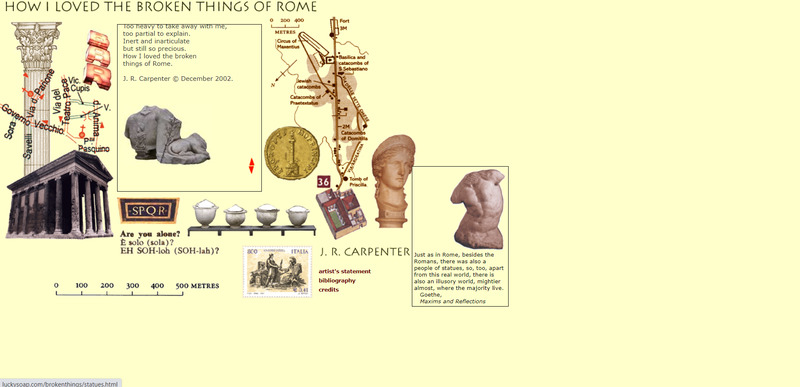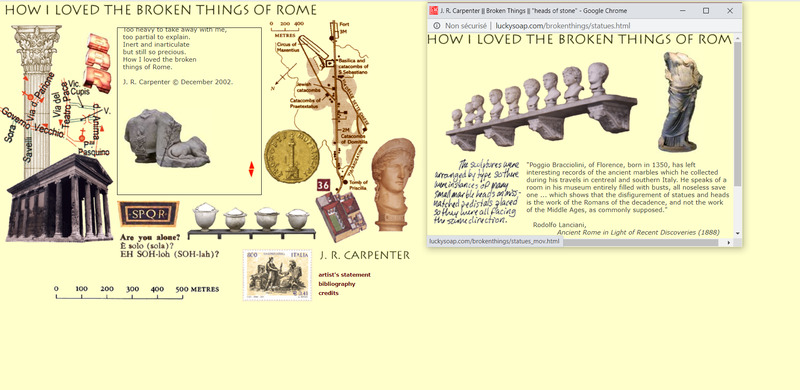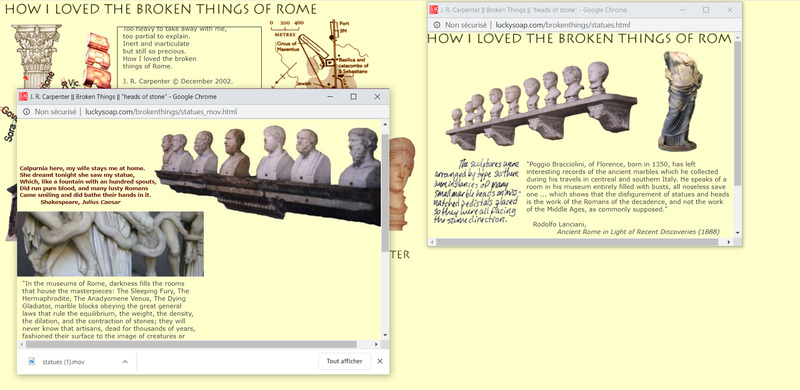How I Loved the Broken Things of Rome
Contenu
-
Titre
-
How I Loved the Broken Things of Rome
-
Créateur
-
J.R. Carpenter
-
Date de création
-
2005
-
Langue
-
Anglais
-
Résumé
-
L'œuvre se présente en une page beige avec un poème central, puis des images tout autour. Le poème en est un de Carpenter qui raconte son voyage à Rome. Tout autour, des photographies, des illustrations et des cartes de la ville. Le lecteur peut mettre sa souris sur tous ces éléments et lire un bout de texte, une citation sur Rome que l'autrice a lié à l'image. Le lecteur peut aussi cliquer sur l'image, ce qui ouvre une nouvelle petite fenêtre internet. Celle-ci mène à un texte plus long du même passage / livre / de la même œuvre que l'autrice a citée, puis à de nouvelles images. Le lecteur ne peut pas interagir avec certaines de ces fenêtres, mais d'autres lui permettent de cliquer sur la nouvelle image et ainsi ouvrir une autre fenêtre ou de télécharger un vidéo. Le lecteur se promène donc dans l'œuvre en cliquant d'image en image, puis en lisant le poème central qu'il peut faire défiler en laissant sa souris sur les flèches rouges à côté du poème, flèches qui pointent vers le haut et vers le bas.
-
Description
-
« "How I Loved the Broken Things of Rome" pieces together fragments of history, poetry, video, photography and cartography collected during an extended stay in Rome. This work reflects upon certain gaps - between the fragment and the whole, between the local and the tourist, between what is known of history and what is speculative. Rome is among the largest and oldest continuously occupied archaeological sites in the world. Daily life is complicated, even for the locals. Everything is running late, circuitous, or quasi-rotto. Romanticism and pragmatism must coexist. My struggles with slang, schedules, and social vagaries reminded me acutely of when I first moved to Montréal. Understanding what's going on around me now seems to be less a question of the acquisition of language than one of overcoming the dislocation of being a stranger. In her poem « The Fall of Rome: A Traveller's Guide » Montréal poet Anne Carson writes: "A stranger is someone desperate for conversation." I certainly found that to be the case. There were days in Rome that I did not, could not, speak to anyone. Oxford Archaeological Guide and cameras in tow, I tried to capture something of the impossibly elusive and fragmentary nature of language amid Rome's broken columns, headless statues and other, often unidentifiable, ruins. »
-
Source : « How I Loved the Broken Things of Rome » sur le site de l'auteure
-
Thèmes
-
Rome
-
Voyage
-
Différence
-
Tourisme
-
Vie locale
-
Histoire
-
Étrange
-
Étranger
-
Ce qu'on connaît et ce qu'on ne connaît pas
-
Extraits de l'œuvre
-
« Too heavy to take away with me, / too partial to explain. / Inert and inarticulate / but still so precious. / How I loved the broken / things of Rome. »
-
Réception et sources
-
Articles de presse :
-
Rhizome, « Web Launch | How I Loved the Broken Things of Rome », 21 avril 2005.
-
Conférences/communications à des colloques :
-
Présenté en exposition du 13 au 23 avril 2006 au MOCCA lors du Images Festival 2006
-
Liens vers d'autres bases de données ou répertoires d'œuvres numériques :
-
Mathieu Mundviller, « How I Loved the Broken Things of Rome », dans Laboratoire NT2.
-
J.R. Carpenter, « How I Loved the Broken Things of Rome », dans ELMCIP.
-
J.R. Carpenter, « How I Loved the Broken Things of Rome », dans CELL.
-
Autres :
-
J.R. Carpenter, « How I Loved the Broken Things of Rome », dans Google Livres, 2002, 30 p.
-
Personne ayant créé la fiche
-
Aude Meunier-Rochon
 Lucky Soap
Lucky Soap






